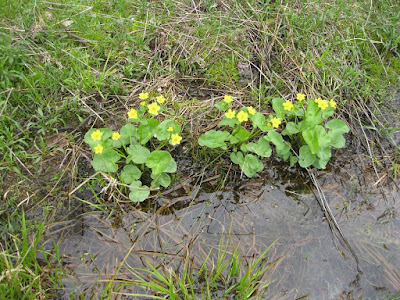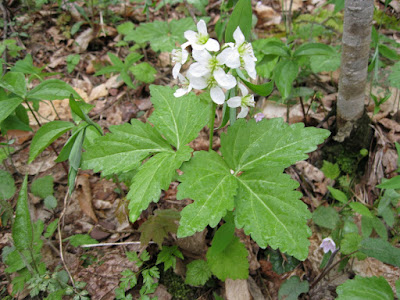When the Trilliums fully open their blossoms, the wild flower season is well on its way. These transplants have been growing here for a decade or more. Single plants have expanded now sending up several flowering stalks. Bare ground does not predominate but plants considered to be weeds are evident. They were cleared out earlier but as always they must return. They will be removed again after the Trilliums have completed their growing season's work.

This shade garden within sight of the road is a more recent project. Most of the moved plants are still alive but few have advanced beyond a single shoot. Just to the right of the flat stone at the bottom of the picture perhaps one dozen Jack In The Pulpits are pushing up new growth. We were concerned that our crowd of deer had ended these plants with repeated deep hoof stabbings. If nothing else, the scattered wire cages have made it difficult for the deer to walk here. The Woodland Phlox in the upper right corner is densely covered with white blossoms. A favorite snack of the deer required the placement of a circular wire cage. A curved swath of recently planted Trilliums fills the center of the photo.

Our point and shoot camera does not accurately capture the color of this Jacob's Ladder flowers. In the upper left corner find the Twin Leaf plants now encased in a wire cage. It took far longer then it should have for us to focus in on predation as the cause of this plant's repeated disappearances. Slowly we catch on. The wire certainly detracts from the natural look that we strive to create but at least the plants remain alive now.
To most people this might not look like much but we finally have two Painted Trilliums that appear determined to open flowers this year. The purpose of flowers is to produce seed intended to establish the next generation of plants. We are wildly pleased with the prospects of open flowers and intend to remain above this land long enough to at least see an increase in the number of these plants growing here.
This Woodland Phlox was seen in the background of an earlier photo but we feel that it deserves no less than a picture of mostly it. This is a hardy plant despite of its attraction of the deer but we expect to see numerous plants scattered about garden.
This is not the first picture of our Bloodroot. No flowers were produced this year but there is a fairly large number of new plants growing from old seed. If the weather cooperates, we should see perhaps three blossoms here next year accompanied by several small second year plants promising future flowers.
This planting of Cardinal Flower has been left largely alone. Some Chrysanthemum stems were scattered about following snow melt but otherwise these plants have been on their own. The remaining Wild Geraniums need to be removed. Their above ground growth appears small and attractive but the underground root mass is huge.
This is the northern tip of Moss Island. The white flowered Shooting Stars have settled in nicely but the moss clumps barely cling to life. These plants simply need more moisture and denser shade. A heavy rain will turn them green but only for a short period of time. Still, their determination to remain alive is at least inspiring.
Our digital camera is outdated and showing signs of rigor mortis. It worked today but I don't know about tomorrow. Eight pictures is perhaps excessive for a post but who knows when its replacement will actually arrive?












































